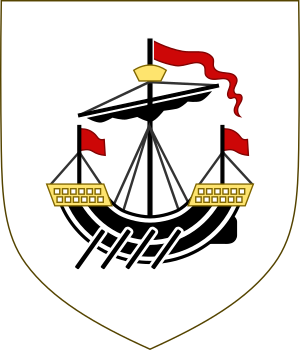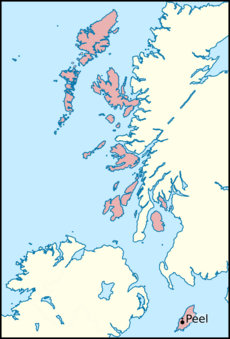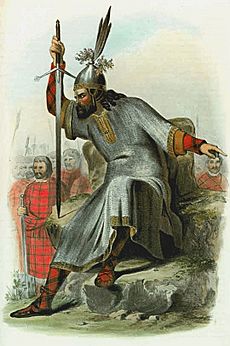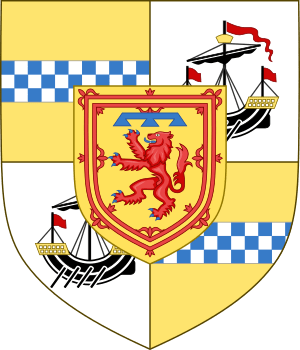Lord of the Isles facts for kids
Quick facts for kids Lordship of the Isles |
|
|---|---|
 |
|
| Creation date | c. 875 |
| Present holder | Prince William, Duke of Rothesay |
| Heir apparent | Prince George |
The Lord of the Isles (or sometimes King of the Isles) was a powerful ruler in Scotland long ago. This title, called Triath nan Eilean in Scottish Gaelic, goes back to the 12th century. It started with a leader named Somerled.
His family, the Norse-Gaels, ruled the Isle of Man and many islands off the west coast of Scotland. They were very strong because they controlled the seas with their fleets of galleys (special ships called birlinns). Even though they sometimes had to say they were loyal to the kings of Norway, Ireland, or Scotland, they mostly ruled their lands independently for hundreds of years.
Their territory was huge! It included much of Argyll, and islands like Arran, Bute, Islay, the Isle of Man, and the Hebrides. At their most powerful, they owned more land and had more influence than almost anyone else, except the kings of England and Scotland.
The time of the MacDonald Lords ended in 1493. King James IV of Scotland took away their lands and titles from John MacDonald II. After this, the MacDonald Clan often fought against the Scottish kings to get their Lordship back. Today, the title "Lord of the Isles" is held by the duke of Rothesay. This is usually the eldest son of the King of Scots, who is also the Prince of Wales. So, Prince William is the current Lord of the Isles.
The main home and meeting place for the Lords of the Isles was Finlaggan on Islay. This was true for both Somerled and the later Clan Donald rulers.
Contents
The Lords of the Isles: Rulers of the Waves

The west coast and islands of Scotland have a long history. Around the 4th century, people from Ireland called Gaels settled there, and their language became common. Later, in the 8th and 9th centuries, Vikings from Norway began raiding and invading. The islands became known as Innse-Gall, meaning "Islands of the Foreigners" to the Gaels.
Around 875, Norwegian leaders came to these islands. They wanted to avoid being controlled by King Harald Fairhair, who was uniting Norway. But Harald followed them and conquered the Hebrides, Man, and the Shetland and Orkney Islands. The people of the Isles, both Gaels and Norse, rebelled. Harald sent his cousin, Ketill Flatnose, who then became the first King of the Isles.
Scotland and Norway often argued over who controlled these islands. Over time, different rulers emerged. One important story tells of King Magnus Bareleg and King Edgar of Scotland making a deal in 1098. They decided who would control which areas. A legend says that King Magnus even had a small boat pulled across a narrow strip of land at Tarbert. He was at the helm, which supposedly made the Kintyre peninsula part of his island kingdom.
The Rise of Somerled
The true start of the Lords of the Isles as a powerful dynasty came with Somerled. He was the grandson of Gilledomman, an earlier ruler. Somerled began taking control of the Isles around 1135, and by 1156, he had even gained the Isle of Man. He is known as the founder of the dynasty that became the Lords of the Isles.
Somerled had both Celtic/Gaelic and Norse family roots. His name, Sumarlidi, means "summer warrior" or "Viking" in Old Norse. He took on important titles like Lord of Argyll and King of the Hebrides. His family history connected him to the Norse Kings of Dublin and the High Kings of Ireland.
After Somerled died in 1164, his lands were divided among his three sons and his brother-in-law, the King of Man.
- The King of Man controlled Man, Lewis, Harris, and Skye.
- Somerled's sons divided the rest:
- Dougall (whose family became Clan MacDougall) ruled areas like Morvern and Mull.
- Ranald likely controlled the southern regions, including Saddell Abbey.
Later, Ranald's sons, Donald Mor McRanald and Rory, became very important. Donald Mor McRanald gave his name to the famous Clan Donald. His family controlled places like Islay, Jura, and Kintyre. Rory's family (the Clan Macruari) ruled areas like Uist and Arran.
The MacDonald Lords and Their Power

The Lords of the Isles were masters of the sea. They used their galleys (birlinns) for both fighting and travel. These ships were very important for their power. They were strong, clinker-built boats with a square sail and many oars.
Somerled, the first Lord, even improved these ships around the 12th century. He developed the stern rudder, which made the galleys much easier to steer than the older Viking ships. These powerful ships allowed the Lords to fight sea battles and attack castles located near the coast. The Lords even set rules for their subjects, saying how many and what size of galleys each area had to provide for their service.
Important MacDonald Lords
Here are some of the key leaders from the Clan Donald who held the title of Lord of the Isles:
- Somerled
- Ragnall
- Donald
- Angus Mor MacDonald
- Alasdair Óg of Islay
- Aonghus Og of Islay
- John of Islay I, Lord of the Isles
- Domhnall of Islay, Lord of the Isles
- Alexander of Islay, Earl of Ross and Lord of the Isles
- John of Islay II, Earl of Ross and Lord of the Isles
- Angus Óg
The Council of the Isles

The Lord of the Isles didn't rule alone. He had a special group of advisors called the Council of the Isles. This council would meet to help the Lord make important decisions.
According to historical records, the council had different levels of members:
- Four "great men" who were direct descendants of the Clan Donald royal family.
- Four of the most important nobles, often called "lords."
- Four "thanes," who were landowners with less power.
- Other "freeholders" or important landholders.
The members of the council could change depending on the time and what was being discussed. For example, in 1545, a list of council members included important chiefs like Hector Maclean of Duart and John Macdonald of Clanranald.
The End of the MacDonald Lordship
The Lords of the Isles were very independent from Scotland. They acted like kings of their own lands well into the 15th century. But in 1462, John MacDonald II, who was the Lord of the Isles at the time, made a secret agreement. He signed a treaty with Edward IV of England to help him conquer Scotland.
This treaty showed that the MacDonald Lords saw themselves as independent rulers. They could make deals with other countries just like a king would. However, a civil war in England, called the Wars of the Roses, stopped this plan from happening.
When King James IV of Scotland found out about John II's alliance with England in 1493, he was very angry. He took away all of John II's ancestral lands, estates, and titles. King James IV had a much larger army and was able to force his will on the west coast of Scotland. Even so, there were still many uprisings and rebellions by the MacDonalds who wanted their Lordship back.
Even though the Lordship was taken from the MacDonald family in the 15th century, their leaders have continued to fight for its return. One famous rebellion was Dubh's Rebellion. Since then, the eldest son of the Scottish (and later British) monarch has been given the title "Lord of the Isles." This basically combined the old kingdom of the Isles with the rest of Scotland.
The actual power of the Lordship ended in the 15th century. Today, the title is mostly honorary. It reminds people of the time when the Scottish king took control of this ancient Norse-Gaelic lordship. Currently, William, Prince of Wales holds the title of Lord of the Isles. He also has other titles like Duke of Rothesay and Prince and Great Steward of Scotland. His wife, Catherine, is known as the Lady of the Isles.
Armorials
The special shield or "arms" used by the Lord of the Isles changed over time. But a famous design from 1542 shows a golden shield with a red eagle. This eagle has black beak and claws. On top of the eagle is a black galley, which is a type of ship. The red eagle first appeared on the arms with Donald Macdonald, sometimes called Donald of Harlaw. He used it after winning a battle in 1411.
See also
- Lord of Islay
- Kingdom of the Isles
- Donald Dubh
- Battle of Harlaw



